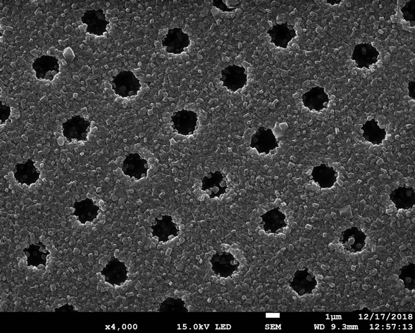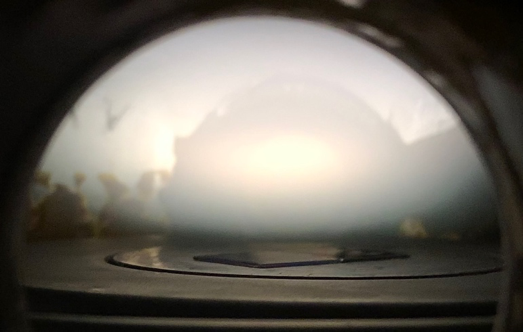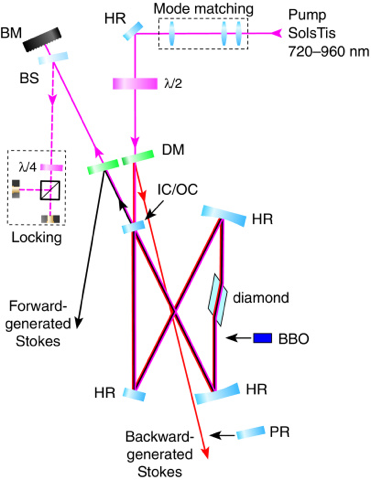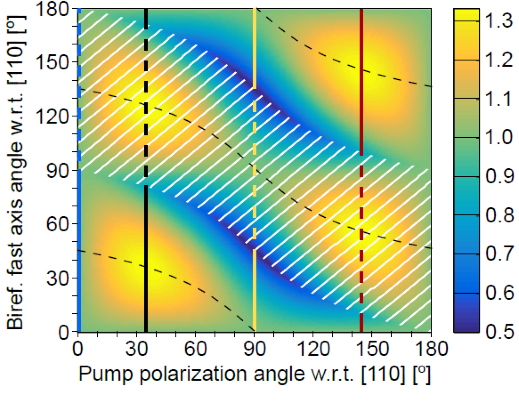Our research
Brown Group
Biological Quantum Science
In recent years, nanodiamonds (< 100nm in size) have emerged from primarily an industrial and mechanical applications base, to potentially underpinning sophisticated new technologies in quantum science and biology. In addition to their chemical and physical stability, nanodiamonds have color centres whose properties make them attractive bio-labels for imaging and tracking.
Further information
The bright and stable photoluminescence, as well as the straightforward surface functionalisation for targeting to biological structures, has allowed us to begin to probe cellular processes down to the single-molecule scale; one of the primary goals of biomedical science and, ultimately, therapeutics.
Research in our group is focused on developing methods to process detonation nanodiamonds to use for the imaging and tracking of targeted biomolecules in complex biological systems. This includes research on the processing and characterising of small nanodiamonds with color centres (~4 to 200 nm), as well as controlling and tailoring their surface chemistry, for use in biological environments and quantum nanotechnologies. We are exploring applications ranging from using nanodiamonds as superior biological markers to, potentially, developing novel bottom-up approaches for the fabrication of hybrid quantum devices that would bridge across the bio/solid-state interface.
Members
Shahrzad Baboli (Research Assistant)
Joyce Demate (Masters)
Collaborators
Dr Alf Garcia-Bennett
Dr David Inglis
A/Prof Thomas Volz
Prof James Rabeau (USyd)
Dr Carlo Bradac (UTS)
Dr Fabio Isa (CSIRO)
Alumni
Dr Jana Say – PhD 2014
Dr Ishan Das Rastogi – PhD 2016
Mr Ajay Hasija – Masters Radiopharm Sc. 2018
Ms Wan Shu Chem – Masters Radiopharm Sc. 2018
Ms Shahrzad Baboli – Masters Radiopharm Sc. 2018
Publications
Publications
https://researchers.mq.edu.au/en/persons/louise-brown
Influence of surface composition on the colloidal stability of ultra-small detonation nanodiamonds in biological media. C Bradac, ID Rastogi, NM Cordina, A Garcia-Bennett, LJ Brown. Diamond and Related Materials 83, 38-45 (2018)
Nano‐assembly of nanodiamonds by conjugation to actin filaments. C Bradac, JM Say, ID Rastogi, NM Cordina, T Volz, LJ Brown. Journal of biophotonics 9 (3), 296-304 (2016)
Three-dimensional optical manipulation of a single electron spin. Geiselmann M, Juan ML, Renger J, Say JM, Brown LJ, de Abajo FJG, Koppens F, Quidant R. Nature Nanotechnology 8, 175-179 (2013)
Mildren Group
Advanced laser materials and optics
Our group focuses on exploiting the properties of diamond to address major problems in optical sciences. We take advantage of the symmetry, tight covalent binding and high atomic density of the intrinsic lattice to explore extreme phenomena in areas of quantum physics, photonics and beyond.
Further information

Our research seeks to exploit the extraordinary optical and physical properties of diamond. Owing to diamond’s high gain for stimulated scattering (Raman and Brillouin), outstanding thermal conductivity and broad optical transmission, diamond is enabling miniature sources for quantum systems, sensing and laser sources with power, narrow linewidth and wide wavelength range.
Currently we have programs in high power lasers, quantum random number generation, narrow linewidth lasers for cold-atom physics and UV-laser direct-write fabrication of diamond functional surfaces.
Members
Robert Williams (postdoc)
Amanuel Berhane (postdoc)
Ondrej Kitzler (postdoc)
Christopher Baldwin (PhD)
Zhenxu Bai (PhD)
Mojtaba Moshkani (PhD)
Xuezong Yang (PhD)
Collaborators
Friedrich-Schiller University and Fraunhofer IOF (Jena, Germany)
University of Sydney
DST Group
CERN (Switzerland)
Harbin Institute of Technology (China)
Naval Research Labs (USA)
DLR (Germany)
Alumni
Alex Sabella (DST Group)
Hadiya Jasbeer (postdoc)
Soumya Sarang (University of Central Florida)
Sergei Antipov (Finisar Corp.)
Aaron McKay (Finisar Corp.)
Publications
https://researchers.mq.edu.au/en/persons/rich-mildren/publications/
L. Weston, J. E. Downes, C. G. Baldwin, E. Granados, Sherif Abdulkader Tawfik, X. Y. Cui, C. Stampfl and R. P. Mildren, "Photochemical etching of carbonyl groups from a carbon matrix: The (001) diamond surface," Phys Rev. Lett., vol. 122, 016802, (2019).
R. J. Williams, O. Kitzler, Z. Bai, S. Sarang, H. Jasbeer, A. McKay, S. Antipov, O. Lux, D. J. Spence, and R.P. Mildren, "High Power Diamond Raman Lasers," IEEE J. Sel. Top. Quant., vol. 24, No. 5, 1602214 (14 pages), (2018).
A. Lehmann, C. Bradac, and R. P. Mildren, "Two-photon polarization-selective etching of emergent nano-structures on diamond surfaces," Nature Commun. vol. 5, 3341 (2014)
Downes Group
Low-temperature diamond for electronics applications
Diamond is an extreme material; it is the hardest, the best thermal conductor and one of the most broadly transparent to light. While these properties would make it excellent for use in electronics, the high temperatures used for diamond growth are not compatible with this application. We are developing new diamond growth technologies at low temperatures that are compatible with many electronics, opening up a new array of applications in areas from 5G communications, state-of-the-art radar to high-efficiency water sterilisation.
Further information


Diamond is an extreme material; it is the hardest, the best thermal conductor and one of the most broadly transparent to light. Synthetic diamond is grown principally using one of two technologies, MECVD – microwave excited chemical vapour deposition or HPHT - high-pressure – high-temperature. While HPHT mimics the conditions for natural diamond growth, MECVD literally grows diamond from a gas. Specifically, hydrogen and methane (and optionally traces of other gases) are excited using a microwave source in a low-pressure environment. Excited gas species interact in a complex way with the sample surface and ideally diamond is formed. This is typically performed at 950ºC.
The Downes group develop and study new processes and technologies to enable high-quality diamond growth at low temperatures (300ºC), enabling its use in a multitude of new applications such as 5G communications to state-of-the-art radar to high-efficiency water sterilisation.
Members
Ms Fatima tuz Zahra (PhD 2017-)
Collaborators
Prof. Rich Mildren (MQ Physics) Mechanism of 2-photon laser etching of diamond
Prof. Barbara Messerle (MQ Chemistry) Diamond tethering of organo-metallic catalysts
Prof. Michael Heimlich (MQ Engineering) Diamond encapsulation of electronic devices
Prof. Frank Klose (ANSTO / Guangdong Technion Israel Institute of Technology in Shantou) Neutron studies of magnetic semiconductors
Prof. Sean Cadogan (UNSW Canberra) Mossbauer spectroscopy of magnetic semiconductors
Alumni
Dr Jacob Evans (2019), now at Risk Frontiers
Dr Chris McMahon (2017), now studying BCom in Italy
Dr Josh Brown (2014), now at BluGlass Ltd.
Dr Patrick Chen (2012), now at BluGlass Ltd.
Publications
Photochemical etching of carbonyl groups from a carbon matrix: The (001) diamond surface Weston, L., Downes, J. E., Baldwin, C. G., Granados, E., Abdulkader Tawfik, S., Cui, X. Y., Stampfl, C. & Mildren, R. P., 8 Jan 2019, Physical Review Letters. 122, 1, p. 016802-1-16802-5 5 p., 016802.
Rogers Group
Novel diamond colour centres for quantum technologies
Tiny glowing artificial atoms in diamond (called colour centres) can be used to store and process quantum information. They underpin a range of emerging quantum technologies in computing, communication, and sensing. We explore the details of how colour centres work in order to both engineer more advanced applications and guide an investigation of novel colour centres with attractive properties.
Further information
Colour centres in diamond are attractive architectures for interfaces between atoms (which can store quantum information) and photons (which can transmit this information). This enables a range of advanced sensing techniques, as well as quantum networks and computation.
As well as the widely-adopted nitrogen-vacancy centre, we study and apply the silicon-vacancy and germanium-vacancy centres in diamond.
Members
Benjamin Snowdon (MRes)
Omar Muhieddine (Mres)
Collaborators
Marcus Doherty – ANU
Fedor Jelezko – Uni Ulm
Alexander Kubanek – Uni Ulm
Alastair Stacey – Melbourne
Andrew Greentree – RMIT
Jan Jeske – Fraunhofer Institute
Alumni
Matthew Joliffe (MRes)
Oliver Conquest (MRes) – now employed in industry.
Publications
https://researchers.mq.edu.au/en/persons/lachlan-rogers
P. Siyushev, M. H. Metsch, A. Ijaz, J. M. Binder, M. K. Bhaskar, D. D. Sukachev, A. Sipahigil, R. E. Evans, C. T. Nguyen, M. D. Lukin, P. R. Hemmer, Y. N. Palyanov, I. N. Kupriyanov, Y. M. Borzdov, L. J. Rogers†, and F. Jelezko, Optical and microwave control of germanium-vacancy center spins in diamond. Phys. Rev. B, vol. 96, 081201, (2017)
U. Jantzen, A. B. Kurz, D. S. Rudnicki, C. Schäfermeier, K. D. Jahnke, U. L. Andersen, V. A. Davydov, V. N. Agafonov, A. Kubanek, L. J. Rogers†, and F. Jelezko, Nanodiamonds carrying quantum emitters with almost lifetime-limited linewidths. New J. Phys, vol. 18, 073036, (2016)
L. J. Rogers† , K. D. Jahnke, T. Teraji, L. Marseglia, C. Müller, B. Naydenov, H. Schauffert, C. Kranz, J. Isoya, L. P. McGuinness, and F. Jelezko, Multiple intrinsically identical single-photon emitters in the solid state. Nat Commun, vol. 5, 4739, (2014)
Sowman Group
Functional brain development in health and disease
Further information
Part 1
Understanding how the brain works is one of the great scientific challenges of the 21stcentury. Brain function is required for all aspects of our lives from our most complex social interactions to our most basic functions like eating and sleeping. Our research measures brain function in health and disease and attempts to understand how this most basic of organs works. We measure magnetic fields emitted by the brain as it processes information in real time and relate these measurements to human behaviour. We are especially interested in the development of cognition during childhood and how alterations in the normal trajectory of brain function development might give rise to disorders like autism.
Part 2
Measuring magnetic fields emitted by the brain requires a sophisticated device called a magnetoencephalograph. This device requires significant infrastructural support in the form of magnetic shielding and cooling with liquid helium, necessities which make it expensive and limit where it can be located, how easily it can be used and who can benefit from it.
The future of magnetoencephalography lies at the cutting edge of physics, where new sensors that are built from nano-diamond will remove many of the limitations that hinder the development of this brain imaging technology. Nano-diamond based brain and nervous-system measurements will revolutionise our understanding of brain function and have the potential to enhance our understanding and treatment of neurological and mental health disorders.
Members
Postdocs
Dr. Wei He
Dr. Matt Sanderson
Dr. Nick Benikos
PhDs
Margaret Ryan
Hannah Rappaport
Jordan Wehrman
Tatiana Izmaylova
Judy (Di) Zhu
Robert Seymour
Aydin Anic
Ana Murteira
Andrea Constantino
Leonie Lampe
MRES
Poonam Minhas
Melissa Tan
David Collins
Collaborators
MQ Centre for Language Research
Prof. Mitsuru Kikuchi, Kanazawa University
Dr. Tetsu Hirosawa, Kanazawa University
Dr. Chiaki Hasegawa, Kanazawa University
Dr. Akira Toyomura, Gunma University
Alumni
Dr. Andrew Etchell University of Michigan
Dr. Leidy Castro-Meneses Western Sydney University
Dr. Yu Li Chinese University of Hong Kong
Publications
Abnormal time course of low beta modulation in non-fluent preschool children: a magnetoencephalographic study of rhythm tracking, AC Etchell, M Ryan, E Martin, BW Johnson, PF Sowman, Neuroimage 125, 953-963
Adaptive Motor Imagery: A multimodal study of immobilization-Induced brain plasticity, H Burianová, PF Sowman, L Marstaller, AN Rich, MA Williams, G Savage, ...Cerebral Cortex 26 (3), 1072-1080
Development of effective connectivity in the core network for face perception, W He, MI Garrido, PF Sowman, J Brock, BW Johnson, Human brain mapping 36 (6), 2161-2173
Spence Group
Lasers and nonlinear optics
The generation and conversion of laser light has enabled us to generate precision light sources from the THz to the ultraviolet, and from continuous wave to femtosecond pulses. We build new lasers and explore theoretical models to give lasers new capabilities and enable new applications. Diamond with its extreme thermal and nonlinear properties, has the capability to extend lasers into new power and wavelength regimes.
Further information
Using diamond as a wavelength converter, we have shown that we can take a leading precision laser source used for quantum control experiments (the M Squared ‘SolsTiS’ laser), and convert it to reach new wavelengths. We are currently finishing experiments to reach read wavelength around 600 nm, and we will use our new laser source to probe nanodiamonds in the Volz lab.

In collaboration with Prof Mildren, we are developing new theories of nonlinear optics to understand how diamond interacts with laser light of different polarisations. This theory supports and guides experiments to reach ever high power outputs, and more precise wavelengths.

Members
Dr Ondrej Kitlzer
Muye Li
Collaborators
Prof Richard Mildren
Prof Helen Pask
Dr Andrew Lee
Prof David Coutts
A/Prof James Downes
Prof Jason Twamley
Dr Thomas Volz
Prof Gail McConnell, Strathclyde University
Prof Andrew Dunn, Texas University
M Squared Lasers, Scotland
Jenoptik GbmH, Germany
Alumni
Dr Eduardo Granados (SLAC, CERN)
Dr Jipeng Lin (M Squared Lasers, UK)
Dr Alex Butler (Rensihaw PLC, UK)
Dr Michelle Murtagh (Coherent Lasers, UK)
Dr Barbara Zittermann
Dr Aravindan Warrier
Piotr Wargocki
Publications
“Single-longitudinal-mode ring diamond Raman laser”
Kitzler, O., Lin, J., Pask, H. M., Mildren, R. P., Webster, S. C., Hempler, N., Malcolm, G. P. A. & Spence, D. J., 1 Apr 2017, In : Optics Letters. 42, 7, p. 1229-1232
“Spectral effects of stimulated Raman scattering in crystals”
Spence, D. J., 1 Jan 2017, In : Progress in Quantum Electronics. 51, p. 1-45 45 p
“Diamond-based concept for combining beams at very high average powers”, Mckay, A., Spence, D. J., Coutts, D. W. & Mildren, R. P., May 2017, In : Laser and Photonics Reviews. 11, 3, p. 1-10 10 p., 1600130.
Twamley group
Diamond science
Twamley’s research focuses on novel uses of diamond for sensing and quantum technologies. Diamond has unique properties of stiffness, thermal conductivity and is also magnetic. It can host an enormous variety of defects, some of which can be useful for quantum technologies and for sensing. I primarily undertake theoretical studies in collaboration with the leading experimental groups in diamond science but have also started our own experimental work on trapping and levitating diamond in vacuum.
Diamond technology can have direct application to
- precision sensing (magnetic fields, electric fields, inertial sensing and gravimetry),
- quantum communications (development of quantum interfaces between moving qubits – photons – and stationary qubits e.g. quantum memory), and
- quantum computing e.g. diamond is the only room temperature solid state qubit but it is difficult to engineer interactions between diamond qubits
Further information

An example of an diamond technology system to magnetically levitate a micron sized diamond in vacuum using magnetic fields [1].
The field of diamond quantum engineering covers many sub-topics including, optomechanics, superconductors, solid-state quantum devices, optimal quantum control, quantum error correction, algorithms and simulation.
Google Scholar Page is here.
Members
Alumni
- Dr Simon Devitt (UTS)
- Daniel Lombardo (MSc)
- Stephen Dunn MRes
- Clara Javaherian (PhD)
- Dr Mauro Cirio (PhD)
- Dr Michael Delanty (PhD)
- Dr Johann Schoenfeldt (PhD)
- Dr Ressa Said (PhD)
- Dr Gerardo Paz-Silva (PhD)
Relevant Publications
- M.C. O’Brien, S. Dunn, J.E. Downes and J.T, Magneto-mechanical trapping of micro-diamonds at low pressures, App. Phys. Lett. 114, 053103 (2019).
- K. Xia, F. Jelezko and J. T, Quantum routing of single optical photons with a superconducting flux qubit, Phys Rev A 97, 052315 (2018).
- K. Xia and J. Twamley, Generating spin squeezing states and Greenberger-Horne-Zeilinger entanglement using a hybrid phonon-spin ensemble in diamond, Phys. Rev. B 94, 205118 (2016)
- M. Cirio, G.K. Brennen and J. Twamley, Quantum Magnetomechanics: Ultrahigh-Q- Levitated Mechanical Oscillators (2012) Phys. Rev. Lett. 109, 147206
- G. Waldherr, J. Beck, P. Neumann, R.S. Said, M. Nitsche, M.L. Markham, D.J. Twitchen, J. Twamley, F. Jelezko, J. Wrachtrup, High-dynamic-range magnetometry with a single nuclear spin in diamond, (2012) Nature Nanotechnology 7, 105-108
- P. Neumann, R. Kolesov, B. Naydenov, J. Beck, F. Rempp, M. Steiner, V. Jacques, G. Balasubramanian, M. L. Markham, D. J. Twitchen, S. Pezzagna, J. Meijer, J. Twamley, F. Jelezko, and J. Wrachtrup, Quantum register based on coupled electron spins in a room- temperature solid (2010) Nat. Phys. 6 (4), 249-253.
